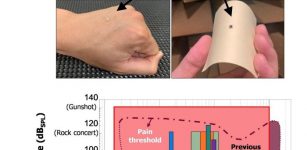A Navigation System More Robust And Accurate Than GPS – Developed
Eddie Gonzales Jr. – MessageToEagle.com – Researchers of Delft University of Technology, Vrije Universiteit Amsterdam and VSL have developed an alternative positioning system that is more robust and accurate than GPS, especially in urban settings.
Illustration of the hybrid optical-wireless network for robust decimetre-level positioning in urban environments. Credit: TU Delft/Stephan Timmers
The working prototype that demonstrated this new mobile network infrastructure achieved an accuracy of 10 centimeters.
This new technology is important for the implementation of a range of location-based applications, including automated vehicles, quantum communication and next-generation mobile communication systems. The results were published today (Nov. 16) in Nature.
Much of our vital infrastructure relies on global navigation satellite systems such as the U.S. GPS and EU Galileo. Yet these systems that rely on satellites have their limitations and vulnerabilities. Their radio signals are weak when received on Earth, and accurate positioning is no longer possible if the radio signals are reflected or blocked by buildings.
“This can make GPS unreliable in urban settings, for instance,” says Christiaan Tiberius of Delft University of Technology and coordinator of the project, “which is a problem if we ever want to use automated vehicles. Also, citizens and our authorities actually depend on GPS for many location-based applications and navigation devices. Furthermore, so far we had no back-up system.”
The aim of the project entitled SuperGPS was to develop an alternative positioning system that makes use of the mobile telecommunication network instead of satellites and that could be more robust and accurate than GPS.
“We realized that with a few cutting-edge innovations, the telecommunication network could be transformed into a very accurate alternative positioning system that is independent of GPS,” says Jeroen Koelemeij of Vrije Universiteit Amsterdam. “We have succeeded and have successfully developed a system that can provide connectivity just like existing mobile and Wi-Fi networks do, as well as accurate positioning and time distribution like GPS.”
An atomic clock
One of these innovations is to connect the mobile network to a very accurate atomic clock, so that it can broadcast perfectly timed messages for positioning, just like GPS satellites do with the help of the atomic clocks they carry on board.
These connections are made through the existing fiber-optic network. “We had already been investigating techniques to distribute the national time produced by our atomic clocks to users elsewhere through the telecommunication network,” says Erik Dierikx of VSL.
“With these techniques we can turn the network into a nationwide distributed atomic clock—with many new applications such as very accurate positioning through mobile networks. With the hybrid optical-wireless system that we have demonstrated now, in principle anyone can have wireless access to the national time produced at VSL. It basically forms an extremely accurate radio clock that is good to one billionth of a second.”
Furthermore, the system employs radio signals with a bandwidth much larger than commonly used. “Buildings reflect radio signals, which can confuse navigation devices. The large bandwidth of our system helps sorting out these confusing signal reflections, and enables higher positioning accuracy,” Gerard Janssen of Delft University of Technology explains.
“At the same time, bandwidth within the radio spectrum is scarce and therefore expensive. We circumvent this by using a number of related small bandwidth radio signals spread over a large virtual bandwidth. This has the advantage that only a small fraction of the virtual bandwidth is actually used and the signals can be very similar to those of mobile phones.”
Written by Eddie Gonzales Jr. – MessageToEagle.com Staff











